9-Hydroxyxanthene
Synonym(s):9-Hydroxyxanthene;9-Xanthenol
- CAS NO.:90-46-0
- Empirical Formula: C13H10O2
- Molecular Weight: 198.22
- MDL number: MFCD00005057
- EINECS: 201-996-1
- SAFETY DATA SHEET (SDS)
- Update Date: 2024-12-18 14:15:30

What is 9-Hydroxyxanthene?
Chemical properties
White needle crystals. Melting point 123℃, easily soluble in cold acetone, soluble in alcohol, chloroform, very slightly soluble in water. Dissolved in concentrated sulfuric acid, it is yellow and has green fluorescence.
The Uses of 9-Hydroxyxanthene
9-Hydroxyxanthene is an Intermediate in the preparation of Propantheline Bromide. It is useful in tests for urea also used in the protection of thiols as their S-xanthenyl (Xan) thioethers, by reaction in the presence of TFA.
What are the applications of Application
Xanthydrol may be used as a derivatization agent for the following:
Analysis of urea in urine and wine samples using high-performance liquid chromatography (HPLC) technique.
Analysis of trace levels of carbamate pesticides in surface water by gas chromatography–mass spectrometry (GC-MS).
What are the applications of Application
Xanthydrol is an intermediate in the preparation of Propantheline Bromide
Definition
9H-Xanthen-9-ol is a derivative of xanthene that is a natural product found in Xanthium spinosum and Xanthium strumarium.
Preparation
synthesis of xanthydrol: The amalgam sodium in dry toluene was warmed to 50°C, the xanthone-ethanol suspension was added, and the temperature was rapidly raised to 60-70°C with vigorous stirring. After the reaction is completed, the mercury is separated. The reaction solution was filtered, the filtrate was poured into the stirred blue distilled water, the 9-hydroxyxanthene was filtered out, washed with water, and dried to obtain the finished product with a yield of 91-95%.
Reactions
9-Hydroxyxanthene (xanthydrol) reacts with a variety of proteins and inactivates certain enzymes. The research data indicate that in acetic acid solution xanthydrol reacts with the following amino acids: arginine, asparagine, cysteine, glutamine, histidine, lysine, and tryptophan. The a-amino group of cu-amino acids does not react with xanthydrol under these conditions, since alanine, serine, isoleucinc, and tyrosine failed to react[1]. This compound could help to increase extraction efficiency, because it could react with ethyl carbamate to form low-polar product, which facilitated transfer ethyl carbamate into organic phase[2].
General Description
Xanthydrol is also known as 9H-xanthen-9-ol. Xanthydrol is a natural drug that has been used in traditional Chinese medicine for treating a variety of diseases. It is extracted from Rhizoma Gastrodiae and Angelicae Dahuricae. It has shown to be effective against various metabolic disorders, including insulin resistance, hyperlipidemia, and diabetes. The mechanism of action of Xanthydrol is not known but it is thought to be due to its ability to activate the immune system by transferring reactions and promoting the production of antibodies. It also shows anti-inflammatory effects by inhibiting the production of prostaglandins and leukotrienes. It can also inhibit angiotensin II, which may reduce high blood pressure and congestive heart failure.
Purification Methods
Crystallise xanthydrol from EtOH and dry it at 40-50o. [Beilstein 17 H 129, 17 I 72, 17 II 146, 17 III/IV 1602, 17/4 V 502.]
References
[1] REACTIONS OF XANTHYDROL. 1954.
[2] Tu Q et al. Quantification ethyl carbamate in wines using reaction-assisted-extraction with 9-xanthydrol and detection by heart-cutting multidimensional gas chromatography-mass spectrometry. Analytica Chimica Acta, 2018; 1001: 86-92.
Properties of 9-Hydroxyxanthene
| Melting point: | 122-124 °C |
| Boiling point: | 275.53°C (rough estimate) |
| Density | 0.83 g/mL at 20 °C |
| refractive index | 1.6620 (estimate) |
| Flash point: | 11 °C |
| storage temp. | 2-8°C |
| solubility | methanol: 0.1 g/mL, clear |
| pka | 13.57±0.20(Predicted) |
| form | Crystalline Powder |
| color | White to off-white |
| Sensitive | Light Sensitive |
| BRN | 10395 |
| Stability: | Stable. Combustible. Incompatible with strong oxidizing agents. |
| CAS DataBase Reference | 90-46-0(CAS DataBase Reference) |
| EPA Substance Registry System | 9H-Xanthen-9-ol (90-46-0) |
Safety information for 9-Hydroxyxanthene
| Signal word | Danger |
| Pictogram(s) |
 Flame Flammables GHS02  Skull and Crossbones Acute Toxicity GHS06  Health Hazard GHS08 |
| GHS Hazard Statements |
H225:Flammable liquids H370:Specific target organ toxicity, single exposure |
| Precautionary Statement Codes |
P210:Keep away from heat/sparks/open flames/hot surfaces. — No smoking. P280:Wear protective gloves/protective clothing/eye protection/face protection. |
Computed Descriptors for 9-Hydroxyxanthene
9-Hydroxyxanthene manufacturer
AVIGYABIOSCIENCES PRIVATE LIMITED
Dr. Silviu Pharmachem Pvt., Ltd.
New Products
(S)-3-Aminobutanenitrile hydrochloride 4-Methylphenylacetic acid N-Boc-D-alaninol N-BOC-D/L-ALANINOL Tert-butyl bis(2-chloroethyl)carbamate 3-Morpholino-1-(4-nitrophenyl)-5,6-dihydropyridin- 2(1H)-one Furan-2,5-Dicarboxylic Acid Tropic acid 1-Bromo-3,5-Di-Tert-Butylbenzene S-2-CHLORO PROPIONIC ACID ETHYL ISOCYANOACETATE 2-Bromo-1,3-Bis(Dimethylamino)Trimethinium Hexafluorophosphate 4-IODO BENZOIC ACID 3-NITRO-2-METHYL ANILINE 1-(2,4-DICHLOROPHENYL) ETHANAMINE (2-Hydroxyphenyl)acetonitrile 4-Bromopyrazole 2-(Cyanocyclohexyl)acetic acid 4-methoxy-3,5-dinitropyridine 1-(4-(aminomethyl)benzyl)urea hydrochloride 2-aminopropyl benzoate hydrochloride diethyl 2-(2-((tertbutoxycarbonyl)amino) ethyl)malonate tert-butyl 4- (ureidomethyl)benzylcarbamate Ethyl-2-chloro((4-methoxyphenyl)hydrazono)acetateRelated products of tetrahydrofuran








You may like
-
 90-46-0 9-Hydroxyxanthene 98%View Details
90-46-0 9-Hydroxyxanthene 98%View Details
90-46-0 -
 90-46-0 98%View Details
90-46-0 98%View Details
90-46-0 -
 Xanthydrol CASView Details
Xanthydrol CASView Details -
 Xanthydrol, 98% CAS 90-46-0View Details
Xanthydrol, 98% CAS 90-46-0View Details
90-46-0 -
 Xanthydrol CAS 90-46-0View Details
Xanthydrol CAS 90-46-0View Details
90-46-0 -
 Xanthydrol 98%View Details
Xanthydrol 98%View Details -
 Xanthydrol CAS 90-46-0View Details
Xanthydrol CAS 90-46-0View Details
90-46-0 -
 Xanthydrol solution CAS 90-46-0View Details
Xanthydrol solution CAS 90-46-0View Details
90-46-0